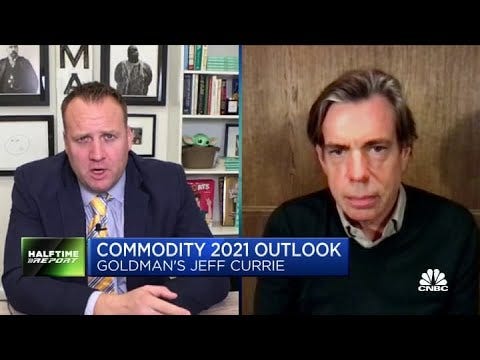“The Truth must dazzle gradually
Or every man be blind —”
Emily Dickenson
Truth can sometimes startle and Jeff Currie, Goldman Sachs’ Global Head of Commodities Research, did startle on February 4, 2021.
On that date, Currie informed the investing world that retail silver investors could never create enough demand to move the price of silver higher by buying silver Exchange Traded Funds (ETFs).
Currie stated “… The shorts are the ETFs. The ETFs buy the physical (silver metal). They turn around and sell on the COMEX to be able to hedge that physical position like any other Corporate. It’s not a naked short like in an equity.”
What was startling about those words was Currie’s apparent admission that silver ETFs were selling claims for metal bars that ETFs beneficially purchased and vaulted for their shareholders thereby creating metal supply into the market to the detriment of ETF shareholders.
Rehypothecation or utilizing client assets for your own purposes is illegal unless a client first agrees.
Further, Currie’s claim that ETFs shorting metal into the market, that is beneficially owned by ETF shareholders, is “hedging” by ETFs in nonsense.
ETFs purchase and hold silver metal for investor clients. The clients hold the risk of price movement on that asset, not the ETFs, and thus there is nothing for ETFs to hedge. Currie describes ETFs merely creating multiple claims on assets that are beneficially held for ETF shareholders.
Currie’s words can be heard here:
In August 2023, Currie left Goldman Sachs.
Blythe Masters States JPMorgan Only Hedges Metal That They Hold For Clients
From 2007 to 2014, Blythe Masters was head of JPMorgan’s Global Commodities division that traded commodities including silver. In 2012, Masters addressed accusations that JPMorgan (JPM) manipulated silver prices by stating that JPM simply acted in markets to hedge metal that that they vaulted for clients, that JPM did not make directional bets, and that JPM maintained a “relatively flat book” when the assets that they vaulted were considered along with the hedging or short selling that JPM executed in the markets.
Masters further said that JPM acted for clients, had no interest in the direction of silver’s price, and that manipulation of silver’s price is “not part of our business model, it would be wrong, and we don’t do it”.
In September 2020, JPM paid a $920 million (M) fine for manipulating gold, silver, platinum, and palladium prices.
Masters’ words can be heard here:
Masters left JPM in 2014 after spending 27 years at JPM and operates a startup blockchain fintech company. In 2014 JPM sold its commodities business and paid $410M to settle an investigation for energy price manipulation within its Commodities group. JPM admitted no wrongdoing.
BlackRock operates the ‘SLV’ silver ETF that currently holds 481 million oz. of silver for its silver investor shareholders. Those silver bars are vaulted by JPMorgan at its vault facilities and the silver is maintained in a Trust by Bank of New York Mellon Corp for SLV.
JPM is a very active trader accounting for 44% of all US bank trading revenues. See: A Bank Regulator Provides a Frightening Look at the Trading Casino Jamie Dimon Has Built Inside His Federally-Insured Bank
A Difficult Situation
If Jeff Currie is correct, ETFs have, over the years, sold short large amounts of their investors’ silver into the market without informing their client investors.
Blythe Masters stated that JPMorgan provides ‘hedges’ to clients and then turns around and acts in the markets to secure those hedges in the market.
The scope of the estimated 4.3B to 6.4B oz. of silver sold short into the London promissory note cash market may well capture ETFs as well as bullion banks that have created these large silver short positions in the City of London’s silver and gold market if they indeed rehypothecated ETF owned assets into the market.
And, again, if Currie is correct these short positions created utilizing silver held for clients may also capture any trustees of the ETFs that have acted against their Trust.
The 6 year and running global silver deficit, worsening to 265M oz. this year, has drawn-down available liquid vaulted global silver stocks that are necessary to meet market demand.
As demand for settlement in physical metal of the large open interest of cash market claims sold into the London market continues and likely will increase, it will at some point start to visibly claim those who have sold these claims for metal into the market.
Best regards,
David Jensen





Good article, clarifies one major component of the silver manipulation vs speculation argument recently reheated.
As we know from the latest report of Michael Lynch, there has been only one (1) seller of physical silver on COMEX for over a year now. One. Uno. Which is "HSBC Customer account".
Listening to Jeff Currie it's quite obvious who that "customer" might be.
And as we know from the famous South Park episode sooner or later it will be "aaaaaaand - it's gone".